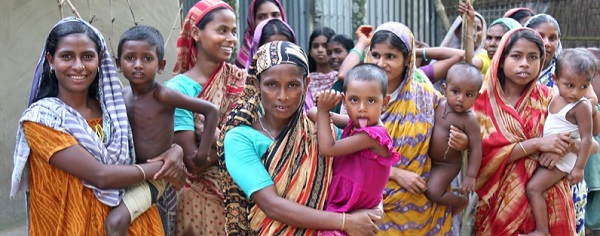Bangladesh has introduced maternal and perinatal death reviews, which triggers action at both the health system and community level. As part of the 2010 pilot, multi-coloured maps were used to plot the number of deaths in the district.
Bangladesh has made encouraging progress in reducing maternal and neonatal mortality over the past two decades. Since 1990, maternal mortality has fallen by two-thirds[i] and neonatal mortality has declined by more than 50 per cent[ii].
As part of the Government of Bangladesh’s efforts to maintain this progress, maternal and perinatal death reviews (MPDR) have been introduced through the existing health system. MPDR triggers actions at both the health system and community level, which has significantly contributed improving maternal and neonatal survival, as well as reducing stillbirths. The strength of MPDR is its ability to encompass both community and facility-based death reviews, as well as an innovative social autopsy system.
The Directorate General of Health Services and Directorate General of Family Planning, under the Ministry of Health and Family Welfare, have been working together to implement the MPDR system. MPDR was first piloted in Thakurgaon district in 2010 under the joint Government of Bangladesh and United Nations (UN) Maternal and Neonatal Health initiatives. During the pilot, UNICEF, Bangladesh partnered with the Centre for Injury Prevention and Research, Bangladesh (CIPRB) to provide technical and implementation support.
Based on the pilot’s success, the Government gradually scaled up MPDR to 12 districts in 2015, covering around 24 million people of the country. MPDR goes beyond MDSR, as it encompasses notification, review, planning and actions for maternal, and neonatal death, and stillbirths.
Mapping
As part of the 2010 pilot, multi-coloured maps were used to plot the number of deaths in the district. Simply, a map was hung up at the Upazila Health Complex and dots manually plotted where a death occurred in the Upazila[iii]. The red dots showed the location of a maternal death, the yellow dots a neonatal death and the blue dots a stillbirth. During national level and district level meetings, a photograph was taken of the Upazila level map and Adobe photoshop used to make a single larger map of the whole district (see map).
Source: Biswas et al, 20144
These simple maps were able to identify areas with high incidence of deaths, which became the focus of review meetings, enabling in-depth analysis and planning of remedial actions[iv].
Example of action
The mapping during the 2010 pilot identified Kashipur Union in Ranishankoil Upazila as having a high incidence of deaths: a total of 40 deaths were notified in 2010, of which 4 were maternal deaths, 21 neonatal deaths, and 15 stillbirths. These findings were presented at Ranishankoil Upazila’s MPDR review meeting where health system bottlenecks for these deaths were identified.
One of the issues identified was the lack of maternal and newborn health services at the community clinic in Kashipur not providing MNH services. The MPDR review committee meeting it was recommended that this clinic was upgraded, and this has now been endorsed by the district MPDR committee, and finally agreed at national-level MPDR meeting.
Subsequently, a trained community skilled birth attendant was deployed at this clinic, a government doctor was assigned to run an outdoor clinic, and the referral system was strengthened. These actions resulted in substantial improvement, which is reflected by a reduction in total deaths notified in Kashipur Union from 40 deaths in 2010, to 22 deaths in 2012[v].
Lessons learned
- Mapping is a simple tool to help visualise, know and think about what is going on in the community. Stakeholders can stand in front of it and discuss remedial actions without having to wait for the data to be analysed.
- Upholding confidentiality and ensuring no blame is important to encourage health managers to share information about deaths.
- Mobilise community networks to help notify when a death occurs. Health workers should be encouraged to build these networks, e.g. by establishing a community group at the community clinic. This too means that the community are engaged in the MPDR system.
- Sharing success stories of the MPDR system, such as that from Kashipur Union, has been influential in encouraging death notification in new areas where MPDR is now implemented.
The future of MPDR in Bangladesh
Since the pilot, the maps are used routinely by health and family planning managers across the Upazilas in the 12 districts where MPDR is implemented. Moreover, data has been integrated in HMIS and enabled District Health Managers to formulate evidence-based local plans and actions as well as tracking district-based MMR and NMR. With support from UNICEF, the government has initiated the development of a national MPDR guideline to guide nationwide scale up of this approach.
For further information on MPDR, please see www.ciprb.org
The case study was written by Dr Animesh Biswas, Senior Scientist at the Reproductive and Child Health (RCH) unit of CIPRB with in-depth review by Dr Riad Mahmud, Health Specialist, UNICEF Bangladesh and Prof Abdul Halim, Director, RCH unit of CIPRB. He is also doing a doctoral study at Örebro University, Sweden. Email: ,
Photo credit: Michael Foley
[i] World Health Organization, UNICEF, UNFPA, The World Bank & the United Nations Population Division. (2014). Trends in Maternal Mortality: 1990 – 2013. Estimates by WHO, UNICEF, UNFPA, The World Bank and the United Nations Population Division. Geneva: WHO
[ii] UNICEF, World Health Organization, The World Bank, & United Nations Population Division. (2014). Levels and Trends in Child Mortality Report 2014: Estimates Developed by the UN Inter-agency Group for Child Mortality Estimation. New York: UNICEF.
[iii] Upazilas are sub-districts in Bangladesh.
[iv] Biswas, A., Rahman, F., Eriksson, C., & Dalal, K. (2014). Community Notification of Maternal, Neonatal Deaths and Still Births in Maternal and Neonatal Death Review (MNDR) System: Experiences in Bangladesh. Health,16, 2218.
[v] Biswas, A., Rahman, F., Halim, A., Eriksson, C. and Dalal, K. (2014) Maternal and Neonatal Death Review (MNDR): A Useful Approach to Identifying Appropriate and Effective Maternal and Neonatal Health Initiatives in Bangladesh. Health, 6, 1669-1679.


